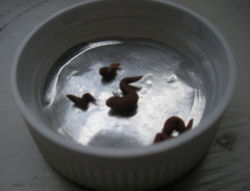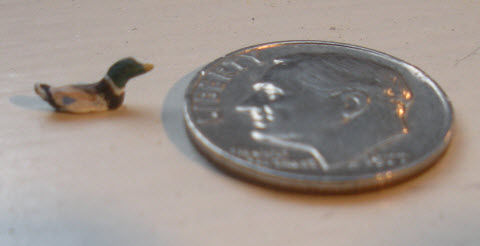|
DIY Duck: Create Your Own N Scale CrittersI wanted to add a couple of water-fowl (Mallard ducks) to the surface of a millpond I am modeling for my N-Scale layout and the scenery around Weimer’s Mill. I am planning a “V”-shaped wave being created by the duck swimming across the pond. If you are looking for a beasty the size of a human head that is not attached to a six-foot critter, painted or unpainted, good luck. Preiser makes some good looking birds in HO, but that’s twice the size I am looking for.Also, there aren't too many that resemble a shiny green headed Mallard in full regalia. A female friend of mine who is into bead making suggested I create my own using Polymer Clay, more commonly known as Sculpy.
When you get down to a duck that is less than an 1/8th inch in length, you won’t have much use for sculpting tools. Think small!Start with a pinch of Polymer clay and cut that in half. Next, roll it between your thumb and forefinger into a tube-shape. Place it on a flat surface and continue the rolling process. You want it to be about a quarter-inch in length and the thickness somewhere between the diameter of a piece of spaghetti and its diameter after it has been cooked.. You won’t need the sauce. Sharpen one end into a duck’s beak. Fold the other end over about half its length for the duck’s body. Flatten it slightly and bend the tail-end upwards slightly. Now you want to curve the beak end into sort of an “S” shape to resemble duck-shaped neck. 
Now you want to curve the beak end into sort of an “S” shape to resemble duck-shaped neck. Hopefully, you’ve rolled out more than one of these min-drakes along with a swan or two and maybe a few pigeons. The point is, you want to harden more than a single duck when you crank up the kitchen oven (best when your wife’s not home). Keep the temperature under 150-degrees to prevent melting the cap which can make a real mess out of your roasted duck. A drake mallard can add a spot of color to an otherwise mundane looking pond surface, specially if it is poised in a v-shaped wake. It is easy to make one on the surface of a Magic Water pond by draping a piece of white thread in a wide “V” back from the front of the duck and picking at the surface along the wake.Before settling your duck into position, spot glue him to the end of a toothpick anchored in clamp or clip to keep it steady. Refer to a Google image of your bird for the appropriate colors. A male mallard (drake) has a head and neck that are green with a white collar. Its front is a rusty brown and a back that is grayish brown and purple. The tail is blue and it curls upwards. To simulate this, I opt for a brownish-grey (mushroom) coat over the entire duck and let this dry. Next color the head and about half of the neck British Racing Green. Once dried, tip the bill in yellow and with your finest brush, paint the white collar. In N Scale you wouldn’t see much more color detail than this. |
Quick-Finder





